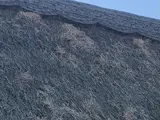Mice and Rats in Thatch
This publication is the first in a series to help thatch owners to:
- Identify what pest is present in the thatch or roof space
- Take preventative measures
- Advise on removing pests from the roof space and possible subsequent repairs due to damage from pests.
Thatched properties aren’t alone in suffering from pests at some time or another, however with thatch the presence of pests can be more visual and little more time consuming to get rid of them from the property.
Identifying mouse and rat presence:
Thatch property owners usually first become aware of something in or on their thatch by straw or reed material disturbance on the surface of the thatch, quite often chewed up balls of thatch material or runs of chewed material under a cut pattern of a ridge can be seen hung up in any wire netting present. This would often coincide with hearing scratching, chewing and footfalls above the ceiling of a bedroom or lean to roof.
Chewed up balls of thatch in short mangled lengths are a tell tale sign that rodents are present and not other pests!
The most likely time of year for a visitation of these pests is from late autumn though to the very early spring the following year, basically the winter period when mice and rats come off the fields and gardens looking for snug winter quarters.
Preventative measures:
Thatchowners generally don’t consider preventative measures until they have suffered an infestation of rodents.
- Either have a contract with a pest controller coming into the winter months or the house owner during the late autumn places traps or places poison stations in safe positions in outbuildings and along the property walls where climbing access is easier such as a lean to and trellis for plants.
- Cut back climbing wall plants or remove entirely.
- Check for building defects and possible access points, such as cracks, missing bricks and building defects under the thatch eaves.
- Place poison stations and traps in access attic spaces.
- Place good quality variable sonic electronic rodent deterrent devices in attic/roof spaces.
- Cut back trees and bushes that overhang the thatch.
The alternative to the above measures is to equip yourself with an air rifle and don’t overfeed your cats…..!
Wire-netting is designed to keep sparrows at bay, it does not deter mice!
During damp seasons, rodent populations increase dramatically!
Dealing with rodents in the roof space and repairs:
Thatchers are not pest controllers, they can advise, but its best to contact specialised pest controllers to get rid of the problem at an early stage as it may take some time before the problem is solved.
When there is no more sign of rodents, thatchers can then attend to any damage and clean down of the surface of the thatch which generally involves removing or rolling up any wire-netting to rectify holes and clean down.
Generally rodent damage looks worse than it is and seldomly leads to leaks, however it is time consuming to get the thatch looking visually pleasing again.
Find a Thatcher
Become a Member
Join the EAMTA
Are you interested in a career as a thatcher? Why not contact us for details as to how you can explore all the opportunities a thatching career can offer.
Contact the East Anglia Master Thatchers Association

